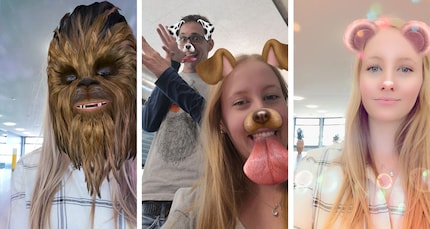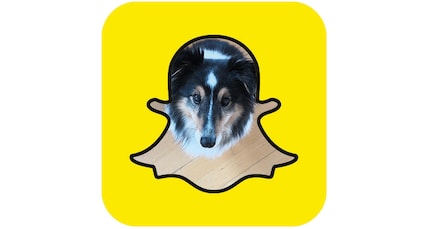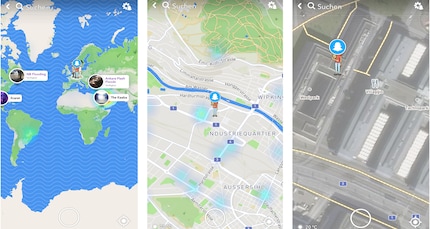
Background information
Nude selfies: How to safely share saucy snaps on the net
by Dominik Bärlocher

Sharing pictures is Snapchat’s main function. But the app is so much more than that. But it’s not that easy to use. Use it carelessly and a lot can go wrong. Not only if you’re sending raunchy photos.
Whenever Snapchat comes up, someone will eventually say: «The app is for sending pictures back and forth.» That’s true, you can use Snapchat to send and receive pictures. But the app is so much more.
Young people use Snapchat intuitively and a lot. Older generations tend to have greater difficulties with it. They see no point in excessively exchanging pictures. What’s more, the app is more complicated than others and not self-explanatory. Personally, I’ve had to explain the app from scratch to four friends.
Snapchat has been around for seven years. And during these seven years, the app has been updated and extended by many features time and time again. Meanwhile, it has shed the sleazy image it had at the start – more so in the US, less so in these parts. And this development is mainly due to the app’s many features.
Snapchat lives for the moment. Capture it with the app’s camera feature, add a little caption and send it to your friends. That’s Snapchat’s basic function.
The recipient can see the pictures for a limited amount of time only. After that, the snaps are deleted. That however is a persistent myth and misconception. Your pictures aren’t deleted, they are simply no longer visible but stored on Snapchat’s servers. Plus the recipient can take a screenshot or photo of your picture or store by means of a different app or programme. In other words, Snapchat is unsuitable for sending nude selfies.
Dominik explains this really well in the following article:
A further Snapchat feature is face recognition. And this is where photo filters come into it. The filters caused a hype that made Snapchat famous. They can be applied to your photos in real time. Before you even take that selfie, you can activate a filter and adapt it as you go.
The filters are regularly updated by Snapchat. A total of 23 filters are available, at least four of them are constantly exchanged.
Chewbacca, dogs or beauty bubbles are just some of Snapchat’s photo filters.In addition to pictures, you can also record and share videos. Every recording has a ten second limit. If that’s not enough, you can string together several recordings and send them individually.
All pictures and videos you take can be stored in the app.
If you don’t want to send the pictures to all your friends individually, you can post them as a personal story. You decide who can view your story: Just your friends, selected friends or the public.
Snapchat’s story feature is basically a brazen copy of Instagram, WhatsApp and Facebook. Having said that, all the big players on the market shamelessly copy from each other.
Unlike other social media platforms, there’s no profile page on Snapchat. Just upload a photo and it will appear in Snapchat’s ghost stencil. That’s it.
Information such as your hobbies, date of birth, friend list, or whatever else is shown on other platfors, is not visible on Snapchat.
Any story you post is visible for one day. After that, it disappears like all the other snaps. The story channel is a one-way thing, meaning that stories cannot be commented on. Your friends can respond to your story with a snap or via the chat feature. However, their reactions can only be seen by you – other friends cannot see third-party comments on your story.
Snapchat doesn’t have a «like» button. Snapchat is not about collecting likes. But it does allow you to see how many people looked at your story and if someone took a screenshot of it.
In February 2018, Snapchat rolled out a huge update and redesigned the app. This move confused and annoyed many users. Strong reactions and a lot of discontent ensued.
But the update was important. It separated the content that was shown on Snapchat – the stories from your friends on the one hand, paid content from bloggers and companies on the other.
Older people tend to find the app too complicated. It’s not intuitive to use and it takes time to find out where all the different features are and which way to swipe to see the filters.
The update was supposed to changed this and make the app easier to understand. Unfortunately, that didn’t happen. It has become even more complicated and the constant changes have made it harder to use.
Another of Snapchat’s features is the Snap Map. The map has been around for a little more than a year. It’s not essential to use Snapchat, but it’s certainly interesting. The easiest way to open Snap Map is to pinch two fingers together when in camera mode – like when you’re zooming out of a camera. The map points out locations with a lot of Snapchat users and places where events are taking place. Plus it allows you to look at shared snaps by other users.
Even if you’re not on Snapchat, you can take a look at the interactive map here.
If your friends give the app permission to do so, their location is shared and updated in the map as soon as they open the app. This is a delicate matter as the Snap Map is extremely accurate and locates a person right up to the house they are in. Most of my Snapchat friends have not activated this localisation feature. And that’s a good thing. Sharing your location offers no added value. But all your Snapchat friends could potentially stalk you with the app.
The Snap Map allows you to locate somebody right down to their house.A friend of mine spaced out and accidentally gave the app permission to show her location on the map. Following her blunder, a mutual friend noticed she often popped up in a small village. Mainly in the evenings. We asked her about it and she was surprised to say the least. It later turned out that she was having a (no longer) secret affair with somebody who lived in that village.
If you’re a Snapchat user, double check that your location is not being shared. If it is, you’ll see a small, white ghost symbol right next to the settings cogwheel in the top right corner of the map.
I like Snapchat. Despite its security issues. It’s just important that you’re aware of the risks.
Every picture you send could pop up somewhere at a later stage. In other words, never send raunchy photos via Snapchat.
I use Snapchat a lot. And I’m aware that it’s highly likely my pictures are stored somewhere. It’s not that I don’t care or want to say I have nothing to hide. I simply don’t send pictures that could potentially harm me in any way.
Keep that in mind and you can have a lot of fun with Snapchat. I’m in a group chat and have been in stitches over some of the snaps that were shared in it. It’s so much better than a WhatsApp chat that floods you with messages.
In summary, I’m just a fan of the concept Snapchat started out with and continued to update and redesign. If you have Snapchat, you can watch the app’s evolution. Features are updated and new stuff is added. Snapchat will remain exciting.
Testing devices and gadgets is my thing. Some experiments lead to interesting insights, others to demolished phones. I’m hooked on series and can’t imagine life without Netflix. In summer, you’ll find me soaking up the sun by the lake or at a music festival.
From the latest iPhone to the return of 80s fashion. The editorial team will help you make sense of it all.
Show all

Following this update, Snapchat is divided in three levels: The camera is located in the middle and is the first thing you see when you open the app. It’s where you see yourself. Double chin and all. Swipe to the right and your list of friends with their content i.e. stories will appear. Swipe to the left and you’ll see the discover page. It’s the page companies can use for paid content. Snapchat continuously updates the content according to your interests. Click on a certain type of content and you will get more of it.
